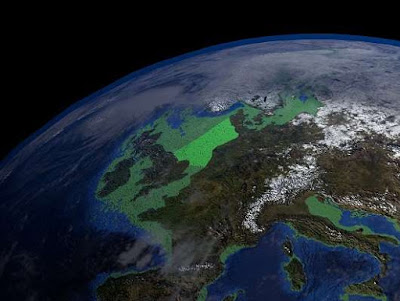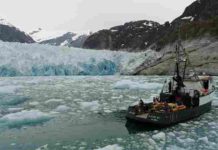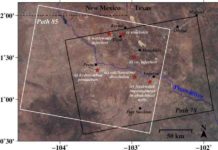Geoscientists at the University of St Andrews are part of a project team awarded one of Europe’s premier research grants for a ground-breaking project to reconstruct an ancient landscape now hidden beneath the North Sea.
They will work with archaeologists, molecular biologists and computer scientists from across the UK to digitally re-construct a prehistoric country approaching the size of Ireland that, following climate change after the last Ice Age, was covered by rising sea levels and now lies beneath the North Sea.
The project team, led by archaeologists at the University of Bradford, will see researchers use modern genetics and computing technologies to digitally repopulate this ancient country, called Doggerland, monitoring its development over 5000 years to reveal important clues about how our ancestors made the critical move from hunter-gathering into farming.
Dr Richard Bates, Senior Lecturer in Earth and Environmental Sciences at the University of St Andrews, said: “Using new technologies – DNA and agent-based modelling – from core samples, together with wide-area seismic data, we will be able to unlock the environmental sequence background to key periods of pre-history. This heralds a completely new approach to both offshore and land archaeological investigations that has the potential to revolutionise the way in which archaeological prospecting is conducted.”
Funded by a prestigious €2.5 million Advanced Research Grant from the European Research Council the project will transform our understanding of how humans lived in this area from around 10,000 BC until it was flooded at the end of the last Ice Age, around 7500 years ago.
Project leader Professor Vince Gaffney, Anniversary Chair in Landscape Archaeology at the University of Bradford, said: “The only populated lands on earth that have not yet been explored in any depth are those which have been lost underneath the sea. Although archaeologists have known for a long time that ancient climatic change and sea level rise must mean that Doggerland holds unique and important information about early human life in Europe, until now we have lacked the tools to investigate this area properly.”
The team will be using the vast remote sensing data sets generated by energy companies to reconstruct the past landscape now covered by the sea. This will help to produce a detailed 3D map that will show rivers, lakes, hills and coastlines in a country which had previously been a heartland of human occupation in Europe but was lost to the sea as a consequence of past climate change, melting ice caps and rising sea levels.
Alongside this work, specialist survey ships will recover core sediment samples from selected areas of the landscape. Uniquely, the project team will use the sediments to extract millions of fragments of ancient DNA from plants and animals that occupied Europe’s ancient coastal plains. The cool, underwater environment means that DNA is better preserved here and offers archaeologists a unique view of how society and the environment evolved during a period of catastrophic climate change and in a prehistoric country that had previously been lost to science and history.
The data from seismic mapping and sedimentary DNA, along with conventional environmental analysis, will be combined within computer simulations, using a technique called ‘agent-based modelling, that will build a comprehensive picture showing the dynamic interaction between the environment and the animals and plants that inhabit it throughout the period – around 5000 years.
The greater North Sea project is part of ongoing work being conducted by Dr Bates that includes lost landscapes around coasts in the Arabian Gulf, off Tanzania and closer to home around the Scottish Islands. In particular, the new DNA techniques and digital reconstructions have been used around Orkney near to the Neolithic World Heritage sites to understand the environments that our earliest ancestors experienced.
Note: The above post is reprinted from materials provided by University of St Andrews.











